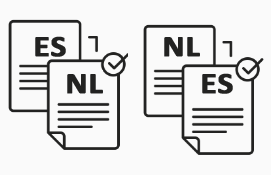Translating from Spanish to Dutch can be challenging, but with the right knowledge, it can be done accurately and fluently. Dutch, spoken primarily in the Netherlands and Belgium, has its unique characteristics that make it different from other Germanic languages. In this article, we will explore how to translate from Spanish to Dutch effectively, helping you overcome common obstacles in the translation process.

Why is it important to translate from Spanish to Dutch?
Although Dutch is not as globally popular as other languages, it holds great significance in Europe and in African countries like Suriname. Translating from Spanish to Dutch is crucial in areas such as international business, diplomacy, and tourism. Additionally, with the growing number of Spanish speakers in the Netherlands, the need to translate documents, websites, and other content has increased considerably.
Common Challenges When Translating from Spanish to Dutch
While both Spanish and Dutch share some Latin roots, there are significant differences. Grammar structures, pronunciation, and vocabulary can vary greatly. It is important to pay attention to the nuances of Dutch to avoid common errors.
- Differences in Syntax
One of the biggest challenges when translating from Spanish to Dutch is the syntax. In Spanish, the word order is more flexible. For example, in Spanish, you can say “Voy al cine con mis amigos” or “Con mis amigos, voy al cine.” In Dutch, however, the word order is stricter, and changing it could lead to confusion.
In Dutch, the equivalent sentence would be: “Ik ga naar de bioscoop met mijn vrienden.” Changing the word order could make the sentence incomprehensible.
- False Friends
Another significant challenge is false friends—words that look similar in both languages but have different meanings. For instance, the Spanish word “actual” means “current,” but in Dutch, “actueel” means “updated” or “relevant,” not “actual.” These errors can cause confusion if you do not verify the context before translating.
Tips for Accurate Translation from Spanish to Dutch
- Understand Dutch Grammar Rules
Dutch grammar is different from Spanish grammar. Be sure to understand the verb conjugations, the use of definite and indefinite articles, and the forms of nouns and adjectives. The rules for plurality and possession also differ, so take extra care when translating.
- Pay Attention to Context
Context is key when translating from Spanish to Dutch. As Dutch has many words with multiple meanings, it is essential to ensure that words are used correctly. For example, “leer” in Spanish translates to “leiden” when referring to leading or guiding, but it translates as “lezen” when meaning to read a book.
- Avoid Literal Translation
One of the most common pitfalls when translating from Spanish to Dutch is making a literal translation. While some words translate directly between the two languages, many do not. As mentioned earlier, false friends are a trap. Also, idiomatic expressions in Spanish may not have a direct equivalent in Dutch, so it’s necessary to find a comparable expression in the target language.
- Use Translation Tools Cautiously
Automated tools can be helpful for quickly translating simple words or phrases, but they should not be relied upon for full sentences. Tools like Google Translate can make errors in verb tenses or grammatical structure, so double-checking your translations is essential.
- Consult Specialized Dictionaries and Glossaries
Using specialized Dutch dictionaries and technical glossaries can be very helpful, especially when translating technical or legal content. This ensures that you use the correct and appropriate terms for the field of expertise.
Common Mistakes When Translating from Spanish to Dutch
- Not Adjusting Verb Tenses Correctly
One of the most complicated areas when translating from Spanish to Dutch is verb tenses. Dutch has fewer verb tenses than Spanish, meaning verb constructions often translate differently. For example, the present continuous in Spanish, like in “Estoy comiendo,” translates to a simpler form in Dutch, such as “Ik eet.”
- Not Adapting Cultural Expressions
Dutch has many expressions tied to its culture that do not have a direct translation in Spanish. These expressions, like “Het is niet mijn kopje thee” (literally “It’s not my cup of tea,” equivalent to “It’s not my thing”), must be adapted so they sound natural in Spanish.
- Omitting Reflexive Pronouns
Dutch uses reflexive pronouns differently from Spanish. It’s crucial to remember to include these pronouns when translating certain sentences. In the case of “Me estoy bañando,” Dutch would be “Ik ben me aan het douchen.” The reflexive pronoun “me” in Spanish needs to be appropriately substituted in Dutch.
Conclusion
Translating from Spanish to Dutch requires a deep understanding of both languages and a clear grasp of their grammatical and cultural differences. By following the guidelines outlined above and avoiding common mistakes, you can ensure accurate and effective translations. Always verify the context and use reliable resources to ensure a natural and correct translation.
Finally, if you need more information, please visit Dutch Translations in Less Than 24 Hours: Fast and Accurate.



